Hockey helmets, as you can imagine, are the most important piece of protective equipment you can purchase. So it goes without saying that while you can manage oversized shin pads or undersized shoulder pads, if your helmet doesn’t fit correctly, you are setting yourself up for a potentially traumatic injury.
That being said, it is most important to recognize that on the current retail scene, there is no “best” or “worst” helmet. There is only the helmet for the best fit for your head. This means that unless you have tried on and fitted a helmet, it is highly recommended that you do not purchase a helmet online or via catalog.
Price Range for Helmets
$60 to $299 for a helmet, $90 to $350 for a helmet with cage sold together, for a new, current model. While a late model helmet, or a helmet that is no longer in production, can be found new and be considered safe, it is highly recommended to avoid used helmets. Used helmets run the risk of decayed foams and stressed plastic that may not provide suitable protection.
Cheap Hockey Helmets vs High End Helmets
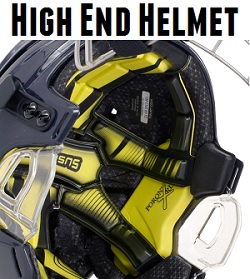 Helmets are basically dictated into two types: EPP (expanded polypropylene), and VN (Dual-density vinyl nitrile).
Helmets are basically dictated into two types: EPP (expanded polypropylene), and VN (Dual-density vinyl nitrile).
EPP foam is a harder, typically black foam, which you may know from bicycle helmets. It often looks like Styrofoam, with visible cells. Because of the rigidity, it is typically lined with softer foam, meant to more cradle the head and create a more snug fit. This type of foam is usually found in the higher price point helmets ranging from $100 – $200. These are typically more expensive helmets than their VN counterparts and will have more options for adjusting and fit.
 VN helmets are lined with a softer foam, that can be pushed or pinched and visibly indented momentarily. This foam is typically tan, gray, or black, and is usually not accompanied by other types of foam. Helmets that utilize the VN foam are typically on the lower end of the price scale, usually $100 or less.
VN helmets are lined with a softer foam, that can be pushed or pinched and visibly indented momentarily. This foam is typically tan, gray, or black, and is usually not accompanied by other types of foam. Helmets that utilize the VN foam are typically on the lower end of the price scale, usually $100 or less.
Common wisdom seems to trend towards the idea that EPP helmets are more protective than VN, but there is no reliable data to support that. Because of the slight give in VN helmets, the helmet usually offers a tigher and more secure fit to the head, whereas an EPP helmet may have the tendency to have gaps and slipping if not a perfect fit.
Most Popular Brands for Hockey Helmets
The major brands in helmets are Bauer and CCM with Warrior being a distant 3rd. In recent years, outlier brands such as Cascade, Mission, Jofa, have been absorbed by the larger brands as well as bigger brands like Easton and Reebok. Mission recently re-debuted its helmet line, and although the brand is now primarily focused on roller hockey, it’s helmets are certified safe for ice hockey.
Advanced Technology in Helmets
Most helmets rely on either the VN or EPP liner that we discussed earlier, and a two piece front to back design for adjustment based on the length of the head. Below, we’ll talk about a few of the more recently engineered helmets that deviate from the usual helmet makeup.
Bauer Re-Akt
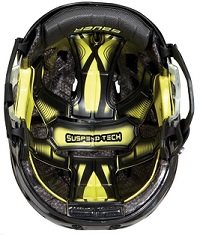 The Bauer Re-Akt comes equipped with a “Suspend-Tech Liner.” This is a harness, lined with Bauers PoronXD foam, which is a light and strong new foam they’re integrating into lots of gear applications. The harness is designed to slow and control rotational impacts that are more likely to cause concussions. The liner, along with large sections of PoronXD, allow the helmet to absorb impact better than a typical helmet, and the sliding adjustment tool on the lower back of the helmet provides the most reliably tight fit of any helmet.
The Bauer Re-Akt comes equipped with a “Suspend-Tech Liner.” This is a harness, lined with Bauers PoronXD foam, which is a light and strong new foam they’re integrating into lots of gear applications. The harness is designed to slow and control rotational impacts that are more likely to cause concussions. The liner, along with large sections of PoronXD, allow the helmet to absorb impact better than a typical helmet, and the sliding adjustment tool on the lower back of the helmet provides the most reliably tight fit of any helmet.
CCM FitLite 3DS
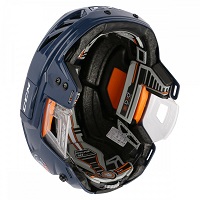 The CCM FitLite 3DS is the latest advancement in helmet technology with an adaptive foam. The D3O foam is interesting in how it absorbs impact. In it’s raw form D30 is a putty which can be squeezed, stretched and twisted. If the D30 putty is struck it firms up and absorbs impact. This is a neat demonstration, however the D30 putty is not used inside helmets, the D30 putty is re-purposed into foam.
The CCM FitLite 3DS is the latest advancement in helmet technology with an adaptive foam. The D3O foam is interesting in how it absorbs impact. In it’s raw form D30 is a putty which can be squeezed, stretched and twisted. If the D30 putty is struck it firms up and absorbs impact. This is a neat demonstration, however the D30 putty is not used inside helmets, the D30 putty is re-purposed into foam.
The D3O foam is said to share similar properties as the putty, however I have not seen a good demonstration showcasing it. According to the CCM website the fitlite has “a cushioning layer made from a low density, lightweight memory foam gives superior comfort. D3O® rate sensitive and shock absorbing smart material adapts to different levels of impacts.”
The FitLite 3DS also has a very simple micro dial at the back for tool less size adjustment. Having a helmet that fits properly is very important and a system like this makes it easy to fine tune the fit.
Will my Helmet Prevent Concussions?
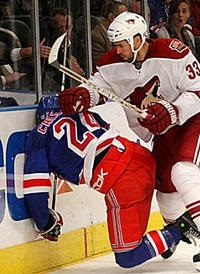 To stem a common misconception, a hockey helmet’s primary purpose is to prevent a skull fracture, not a concussion. A skull fracture or other blunt impact can be dissipated across the shells and foams of a helmet, but a concussion occurs due to rotational forces. What this means is, if your head moves rapidly, such as in a whiplash situation, a concussion may occur even without any impact to the head. While helmet companies have dedicated themselves to creating helmets designed to prevent concussions, the results are not fully known or proven.
To stem a common misconception, a hockey helmet’s primary purpose is to prevent a skull fracture, not a concussion. A skull fracture or other blunt impact can be dissipated across the shells and foams of a helmet, but a concussion occurs due to rotational forces. What this means is, if your head moves rapidly, such as in a whiplash situation, a concussion may occur even without any impact to the head. While helmet companies have dedicated themselves to creating helmets designed to prevent concussions, the results are not fully known or proven.
Another important point on helmets is that it is the only piece of equipment where the used market should not be considered a viable option. Ebay, Craigslist and Play it Again stores should not be pursued for a hockey helmet, as the certifications are often void on resale. This could be an issue if a head injury is sustained, which may negate the insurance of both the helmet manufacturer and the hockey governing body that offers insurance, such as USA Hockey.
How Should a Hockey Helmet Fit?
 In a word, tight. While the style may be for a low hanging chin strap, this is dangerous. The Chin strap should be no more than the width of two fingers below the chin, to make sure the helmet does not come off during a fall, leaving the head and brain unprotected.
In a word, tight. While the style may be for a low hanging chin strap, this is dangerous. The Chin strap should be no more than the width of two fingers below the chin, to make sure the helmet does not come off during a fall, leaving the head and brain unprotected.
The helmet itself should be tight enough that it won’t shake loose when you shake your head up and down or side to side. To adjust the fit the adjustment tabs or screws on the helmet should be loosened, the helmet placed on the head, and with both hands you should push the pieces of the helmet together until it is snug (will not move around). At that point, a teammate can tighten the screws or snap the adjustment tabs closed to maintain the ideal fit. Redness around the head is normal, and is preferential to a loose fitting hockey helmet.
The helmet should sit on or just above the brow line, and should feel snug at the crown, temples, the beginning of the neck, and the forehead. If significant gaps are felt, that helmet is not a proper fit and another option should be considered.
A good fit means the helmet is snug and does not move, shift or rotate while playing but is not so tight that it causes pain or discomfort.
Quick video on how to fit a helmet
Common personal preferences
Note from Coach Jeremy: There are a lot of helmet preferences that I see that will jeopardize your safety. I will touch on a few
Minor hockey players are required to wear a full cage but recreational players are not. Every year I see guys leaving the ice with blood dripping from their eye, nose, or mouth because they prefer a visor or no visor at all. It’s your choice, but I don’t have a dental plan so I wear a full cage
Removing the ear protectors
I’m not really sure why players do this, but I see a lot of guys wearing helmets with the ear protectors removed. I didn’t notice this until after I saw a very gory picture of a player who had JUST taken his ear guards out, only to have a skate graze his ear and slice it in two. Sure it might look cooler, but I’d rather have my ear in one piece.
Hanging Chin Strap
 Some players like to have their chin strap very, very loose. The only reason I can think of is for style. Some will even skate at pick-up hockey with their chin strap undone. This might be cool until that one accident happens and your helmet comes off as you are falling and you crack your head right off the ice. (or get a skate to the head like Taylor Hall). There is also “Cage Hang” or Buckey Hang which we will cover in the Cage / Visor article.
Some players like to have their chin strap very, very loose. The only reason I can think of is for style. Some will even skate at pick-up hockey with their chin strap undone. This might be cool until that one accident happens and your helmet comes off as you are falling and you crack your head right off the ice. (or get a skate to the head like Taylor Hall). There is also “Cage Hang” or Buckey Hang which we will cover in the Cage / Visor article.
The moral of the story is, wear your helmet correctly (Here is one more reason)
Some other preferences and pros and cons of different helmets include airflow, sweat displacement, weight, and comfort.
Some of these factors, such as airflow and sweat displacement, can be nearly impossible to check in the process of purchasing. Online reviews can solve this problem in the shopping process. If sweat displacement seems to be an issue, a thin bandana or athletic skullcap can help solve the problem. However, modification of the inside or the outside of the helmet for weight or airflow reasons can be very dangerous and compromise the protective integrity of the helmet.
How Are Helmets Sized?
 Helmets typically are sized in adult small, medium, and large, as well as youth small, medium, and large. Occasionally, adult extra large and youth extra small helmets can be found.
Helmets typically are sized in adult small, medium, and large, as well as youth small, medium, and large. Occasionally, adult extra large and youth extra small helmets can be found.
It’s important to note that the sizing varies significantly from brand to brand, so head sizes that may be on the fringes between two sizes in one brand should be careful about buying another brand without trying it on first.
Expected lifetime of Hockey Helmets
Every helmet comes with a sticker of certification from various associations. Most certifications are valid for five years of play (some for 6.5). Helmets should not be used beyond this lifespan, as the foams and plastics can degrade and the integrity of the helmet can be compromised, risking injury.
Note from Coach Jeremy: Just because the sticker says the helmet is good for 5 years does not mean the helmet will last that long. After a very hard impact a helmet may need to be replaced.
Care / Maintenance of Helmets
 The biggest issue you will have with helmets are screws coming loose or falling out. It doesn’t happen too often, but when it does you will need to fix it. It doesn’t hurt to carry a helmet repair kit in your bag. If you don’t need it during a season you can bet a guy on your team will so it is nice to have. (The one I linked to has a lot of different hardware that should be everything you need)
The biggest issue you will have with helmets are screws coming loose or falling out. It doesn’t happen too often, but when it does you will need to fix it. It doesn’t hurt to carry a helmet repair kit in your bag. If you don’t need it during a season you can bet a guy on your team will so it is nice to have. (The one I linked to has a lot of different hardware that should be everything you need)
Helmets usually don’t require a lot of maintenance. Simply remove the helmet from the hockey bag after skating, to dry properly to protect screws and attachments from rust or corrosion.
Corroded screws can become difficult to adjust or remove, and the chin or cage strap closures often pull apart when corroded too badly. While this is easy and cheap to replace, it can be frustrating if it happens during a game or practice. If the chin strap or cage straps are not fastened properly, the player should not use the helmet until the pieces have been replaced.
Recommendations When Shopping for a Helmet
While there are many factors to consider, such as cost, weight, looks, comfort, materials, all of them pale in comparison to the importance of the right, tight fit. Other factors can be considered when a good fit is found.
Money saving tips
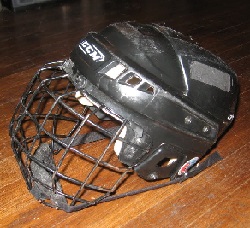 It is important to avoid the used market for a hockey helmet as you do not know what kind of abuse the helmet has gone through, and certification could be expired. If a lower priced option is important, consumers should look for discontinued brands or models, such as Itech, Nike/Bauer, Jofa, Cascade, or Mission, which can sometimes still be found new., often at wholesale prices or less. Also, old models of current brands, such as the Bauer 5000, CCM HT2 or 1052, or Easton S9, and S17.
It is important to avoid the used market for a hockey helmet as you do not know what kind of abuse the helmet has gone through, and certification could be expired. If a lower priced option is important, consumers should look for discontinued brands or models, such as Itech, Nike/Bauer, Jofa, Cascade, or Mission, which can sometimes still be found new., often at wholesale prices or less. Also, old models of current brands, such as the Bauer 5000, CCM HT2 or 1052, or Easton S9, and S17.
Most brands also have low end models, and it’s important to note that these low end models meet certification guidelines and should be considered safe options, although sacrifices may be made in weight, airflow, or looks.
Video on How to fit a Hockey Helmet
More Resources
Hockey Monkey has a nice helmet fitting guide that links to sizing charts for all the major helmet brands
Where to Buy
The first choice for a helmet is to buy locally from your local hockey shop. A store with knowledgeable staff will help you get the right fit. If you don’t have a good hockey shop in your area you can buy helmets online. Just make sure the store has a good return policy in case your helmet does not fit properly.
Recommended online stores
- Hockey Monkey – (largest online hockey retailer)
- Pure Hockey
- Pro Hockey Life (For Canadians)
Learn to Play Hockey from home – Join The Pond for easy to follow video courses, challenges, and a private social group to quickly improve your hockey skills at home

